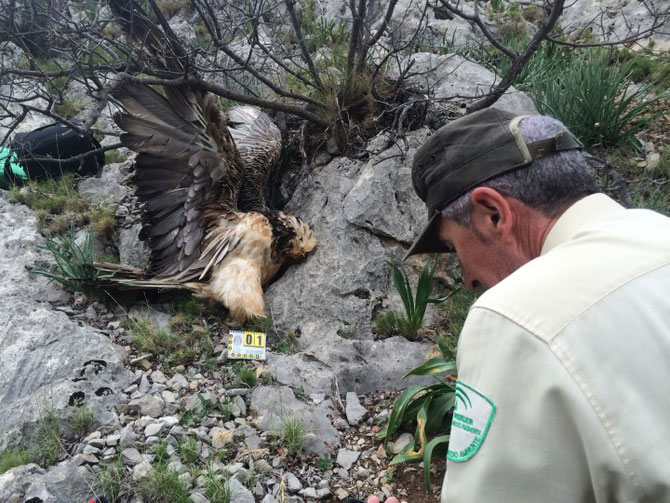A farmer has been convicted of laying out poisoned baits in the Sierra Magina Natural Park in Andalucía in 2016 that killed two Bearded vultures from a reintroduction programme, as well as one Cinereous vulture, a golden eagle and numerous mammals.
He’s been fined 4,500 Euros and is banned from working as a cattle rancher for three years, although this sentence is apparently being appealed.
Further details about this case, including an extensive multi-agency investigation, can be read on the Vulture Conservation Foundation website here.
[One of the poisoned Bearded vultures, photo via Vulture Conservation Foundation]

Tackling the illegal poisoning of birds of prey is taken seriously in Spain with, for example, the deployment of specialist poison detection dogs and investigators given the authority to conduct unannounced spot checks in areas of suspicion. In recent years successful prosecutions have resulted in massive fines, custodial sentences and extended hunting disqualifications for those convicted of laying poisoned baits (e.g. see here, here, here, here and here).
Meanwhile, over here the illegal poisoning of birds of prey (and anything else unfortunate to consume the bait) continues without consequence. These are some of the cases reported this year alone, many during lockdown, and none of them are heading towards a prosecution:
The illegal killing of a white-tailed eagle found on a grouse moor inside the Cairngorms National Park in Scotland (here), the mass poisoning of 23 buzzards in a field in Co Cork, Ireland (here), the poisoning of four peregrines on Guernsey in the Channel Islands (here), the poisoning of a family’s pet dog, believed to have consumed a poisoned bait intended for birds of prey in Nidderdale, North Yorkshire (here), the poisoning of a buzzard found dead on a grouse moor in the North York Moors National Park (here), the poisoning of a buzzard in Nidderdale, North Yorkshire (here), the poisoning of a buzzard and a kestrel in Derbyshire (here), the poisoning of three peregrines and a buzzard in Staffordshire (here), the poisoning of a peregrine in South Yorkshire (here) and the poisoning of two peregrines in North Yorkshire (here).
There may well be further poisoning cases that haven’t yet been publicised.

A good start, this may make others think about doing the same thing.
Found Guilty – Excellent News.
The only shame is that the wretched man didn’t get a custodial sentence.
What a shabby pretence by the artist currently known as Perdix. Such crass posturing fools nobody. We know what side his/her bread’s buttered.
No matter what they do it wont bring them back unfortunately.
Perdix wrote:-
“The only shame is that the wretched man didn’t get a custodial sentence.”
There is another very significant shame. The legislature in the UK do not make any meaningful effort to deal with wildlife criminals in a similar fashion.
I agree whole-heartedly with your statement Perdix. The UK legislature is way behind in getting prosecutions for wildlife crimes to court; let alone someone being sentenced, and then hopefully a substantial fine and custodial sentence.
Something needs to happen to get this sorted.
The evidence was built up over a lengthy period with as many as 40 visits to a carcass where sampling and testing was carried out – not exactly sure of what evidence of attendance at the carcass was presented against this particular individual – it does look like some serious funding was allocated to this – possibly because two of the deaths were to tracked vultures, part of a re-introduction programme. It did, after all, take 3-4 years to get it to court. The fine would still have been nowhere near the cost it would have taken to get it to court, but it does show a determination to get cases to trial.
hi,
Walking into work I found a decapitated Barn Owl on the banks of the Avon…I am presuming an ex captive bird? Did nt have time to report will check it out tomorrow…whats your view..?
If you have any suspicions please report it to the police and to RSPB Investigations.
Peter,
If you think the bird died of unnatural causes, please report the matter.
Ideally the police will need the dead owl for examination.
If you can pinpoint the exact place where you found the bird using “What3Words”- its an app you can download to your phone and allows the authorities to very accurately revisit the scene.
Also it’s also worthwhile taking pictures of exactly how and where you found the bird, and what else is in the immediate surrounding.
I can’t imagine any falconer just discarding a captive bird which dies in a public place. So what you describe sounds suspicious, but the loss of the head could be down to a natural predator trying to eat the carcass?
Worth reporting in case its part of a bigger picture, with other suspicious incidents also reported in the same area.